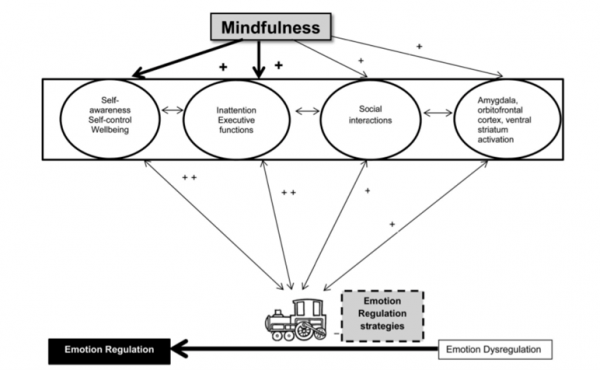
Mindfulness in children
Meet Jaxon, a healthy 12 year old boy with longstanding concentration difficulties. He is disorganized, often submits assessments and homework late or incomplete. He gets in trouble frequently at school for calling out and losing his temper with peers. He is achieving at grade level for most subjects though his teacher feels that he could do better if he put the effort. He is well connected socially with peers and family. His parents feel overwhelmed supporting him and his 2 younger brothers as well as holding fulltime jobs. Then there’s Mica, 13 year old girl in Year 8 with school refusal, anxiety, rigid repetitive behaviours and sensory aversive behaviours. She is an only child from a supportive nuclear family. Lastly, Myra, 10 year old girl in out of home care who struggles with emotional regulation, inattention and learning difficulties. Currently she is in a fairly stable home environment for the past 2 years though she has moved through multiple placements in the past.
These are not uncommon scenarios in my clinical practice.
Does Mindfulness have a role in supporting these children and their families or both? What should we be mindful of whilst teaching mindfulness to children, young people and their families? I am not a mindfulness teacher/coach however this topic intrigues me personally and professionally as I reflect on my practice and on nonpharmacological ways of managing challenging behaviour in children with or without any formal diagnosis.
Mindfulness in the Western society has evolved over thousands of years from ancient religions, in particular from Buddhist practices. It was introduced to the clinical setting in the early 1970s by Jon Kabat-Zinn, an American professor and researcher at the University of Massachusetts Medical School when he started the Mindfulness-Based Stress Reduction Clinic (MBSR) treating adults with chronic pain.
In clinical, psychological or research settings, the commonly used definition of Mindfulness is that by Jon Kabat-Zinn, “the awareness that arises through paying attention in a particular way: on purpose, in the present moment, and non-judgmentally”1. Mindfulness can be a complex concept to grasp. It calls for persistence with learning over long periods of time, the processes involving awareness of thoughts, emotions, sensations in the body and the mind. Mindfulness can be thought of as a way of life, a practice; not just a strategy to be pulled off during crisis.
Benefits of Mindfulness have been reported, initially in adult studies but increasingly studies in children are promising. Physical changes in particular brain areas have been reported with Mindfulness practice; these are areas of the cerebral cortex associated with attention and emotional regulation, grey matter associated with memory and learning and reduction in brain density in areas associated with stress, anxiety and other mental health conditions2,3. This translated to the clinical setting with improved emotional regulation, executive function and social skills (Fig 1) following group mindfulness training to children newly diagnosed with attention deficit hyperactivity disorder4. Research on family based mindfulness training5 is also promising, with improvement of parental emotional wellbeing and decrease in stress thus subsequent enhanced family connectedness. Positive outcomes were also reported in carers of children with emotional health conditions, neurodevelopmental disabilities and adults with mental health conditions6.

Fig 1: Mindfulness and emotion regulation improvements4
Mindfulness can benefit many individuals including children and their parents however we should be mindful that some individuals can experience negative or unpleasant experiences6. When working with children like Mica and Myra, the therapist or Mindfulness teacher should consider their developmental history, psychosocial history, neurodevelopmental diagnosis as well as current family support to weigh the balance of benefits and possible unwanted effects of Mindfulness. Inconclusive evidence for benefits of Mindfulness in children with autism spectrum disorder has been reported recently. Further research will be helpful in providing evidence8 base for Mindfulness in particular groups of children and individuals.
- Kabat-Zinn, J. Full Catastrophe Living: Using the Wisdom of Your Body and Mind to Face Stress, Pain and Illness. 2nd Edition, Revised and Updated. Bantam/Random House. 2013
2. Davidson, R. and Lutz, A. “Buddha’s brain: Neuroplasticity and Meditation”, IEEE Signal Process Mag. 25(1):174-6 2008
3. Danning, D. Griffiths, K. Kuyken W et al. Research Review: The effects of mindfulness-based interventions on cognition and mental health in children and adolescents – a meta-analysis of randomized controlled trials. J Child Psychol Psychiatr 60(3): 244–58 2019
4. Huguet, A. Eguren, J. Miguel-Ruiz, D. et al Deficient Emotional Self-Regulation in Children with Attention Deficit Hyperactivity Disorder: Mindfulness as a Useful Treatment Modality. J Dev Behav Pediatr. 40:425-431. 2019
5. Lo, H. Wong, S. Wong, J. et al The Effects of Family-based Mindfulness Intervention on ADHD Symptomatology in Young Children and Their parents: a Randomised Control Trial. Journal of Attention Disorders 24 (5): 667-680 2020
6. Appleton, P. Barrasin, E. Hepworth, A. et al Effects of a mindfulness-based stress reduction group programme on family carers. Mental Health Practice 23(1) 2020
7. Baer, R. Crane, C. Montero-Marin, J. et al Frequency of self-reported unpleasant events and harm in a Mindfulness-based program in two general population samples. Mindfulness 12(3):763-774) 2021
8. Semple, R. Review: Yoga and mindfulness for youth with autism spectrum disorder: review of the current evidence. Child Adolesc Ment Health 24(1): 12–8 2019
This article has been written for the Australasian Society of Lifestyle Medicine (ASLM) by the documented original author. The views and opinions expressed in this article are solely those of the original author and do not necessarily represent the views and opinions of the ASLM or its Board.



